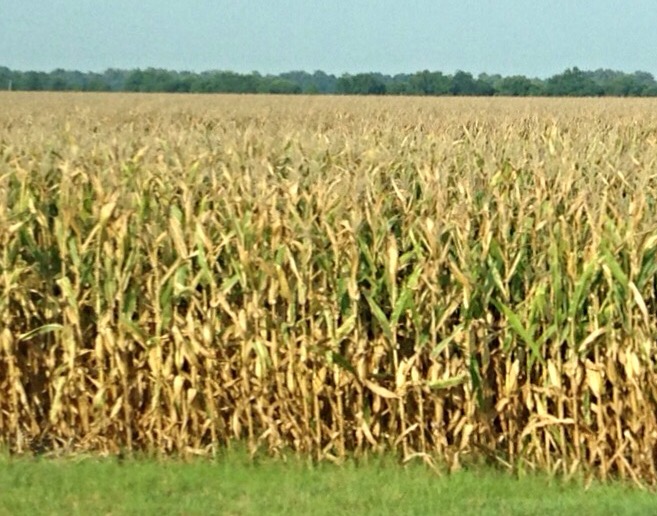
After hot and dry starts and finishes to the U.S. corn and soybean seasons of 2023, USDA will offer its first estimates of crop yields with input from field data at 11 a.m. CDT on Tuesday, Sept. 12. Two reports will be offered by Uncle Sam- the September Crop Production estimates from NASS and the monthly WASDE from the ERS.
Kansas State University Grain Market Economist Dan O’Brien dove into the latest corn, soybean and wheat numbers in an interview Friday with Shelby Varner on the daily podcast and radio program, Agriculture Today. Listen to what O’Brien is thinking ahead of those reports by clicking on the Listen Bar below:
The September Crop Production Report will include field data in USDA’s estimating process. For the 2023 US Corn crop- DTN Reports that the Dow Jones’ survey of 18 analysts has a range of yield guesses from 171.0 to 175.0 bushels per acre (bpa). The average estimate is for a 14.994-billion-bushel (bb) crop, based on a yield of 173.3 bushels per acre.
The same group estimated USDA will lower its estimate of U.S. ending new-crop corn stocks from 2.202 bb to 2.127 bb, still the largest surplus in five years, if true. Friday’s export sales report plus Census Bureau data showed old-crop corn exports totaled 1.659 bb, 34 million bushels (mb) above USDA’s export estimate. Dow Jones expects old-crop ending corn stocks to be estimated at 1.459 bb, but Friday’s report makes an argument for a lower estimate of 1.423 bb, which will also be carried into 2023-24.
For world ending corn stocks, Dow Jones’ survey expects USDA to lower its estimate from 311.05 million metric tons (mmt) to 310.3 mmt (12.22 bb) in 2023-24. If true, it would be the most in five years, but still has a lot of uncertainty with South American crops yet to be planted. For reference, the August World Agricultural Supply and Demand Estimates (WASDE) report showed USDA’s estimate of ending world corn stocks, excluding China, at 109.75 mmt (4.32 bb), also the most in five years.
Another part of Tuesday’s Crop Production report to watch for is the possibility that USDA will adjust its estimates of planted and harvested acres for corn and soybeans, based on new information from the Farm Service and Risk Management agencies. Because planting weather was generally favorable in 2023, any changes on Tuesday are likely to be small.
For soybeans, Dow Jones’ survey expects USDA to reduce its crop estimate from 4.205 bb to 4.139 bb, based on a national yield of 50.0 bushels per acre. The estimated yield range is relatively narrow, between 49.0 and 51.0 bushels per acre. Along with a smaller crop estimate, the survey expects USDA to lower its estimate of U.S. ending soybean stocks for 2023-24 from 245 million bushels (mb) to 213 mb, the lowest in eight years, if true.
USDA’s old-crop ending stocks estimate of 260 mb is expected to be trimmed to 256 mb, but final stocks may eventually go even lower. Friday’s export sales report plus Census Bureau data showed 1.992 bb of old-crop exports, 12 mb more than USDA’s 1.980 bb estimate. The report suggests an old-crop ending stocks estimate of 248 mb.
Dow Jones’ survey expects USDA to lower its snapshot estimate of world soybean stocks from 311.05 mmt to 310.3 mmt (11.40 bb) for 2023-24. If true, it would be the largest soybean surplus on record, but there is much to learn, knowing South American soybeans aren’t yet planted.
For wheat– This remains a busy time of year for wheat as the Northern Hemisphere is finishing harvest and is just starting winter wheat planting. However- there will not be an update on the winter wheat production in the September Crop Production numbers- so the production estimates of August stand for now. That includes the Oklahoma Hard Red Winter Wheat Crop for 2023 estimated at 68.85 million bushels- virutally the same as the crop produced in 2022 while Kansas growing one of its smallest crops in several decades at 208 million bushels- down 15% from a relatively small 2022 crop. South of us in Texas- the 2023 harvest was much larger than the hard hit 2022 crop of 39 million bushels- the 2023 production estimate in August for Texas stands at 70 million bushels- a jump of 79 percent year over year.
Nationally- the US Wheat crop is currently seen at 1.227 billion bushels- up 11% over the 2022 crop year. Globally- DTN says Russia continues to attack grain infrastructure at Ukrainian ports and has effectively shut down access to the Black Sea. Caught in an ongoing war, the fundamentals of wheat remain potentially volatile.
According to Dow Jones’ survey of analysts, only slight reductions are expected in Tuesday’s reports for the U.S. and the world. USDA’s 615 mb estimate of U.S. ending wheat stocks is expected to be trimmed to 614 mb for 2023-24, while USDA’s world ending wheats estimate is expected to come down from 265.61 mmt to 265.0 mmt (9.74 bb), the lowest in seven years. In August, USDA estimated world ending wheat stocks, excluding China at 130.69 mmt or 4.80 bb, the second lowest total in 11 years.














